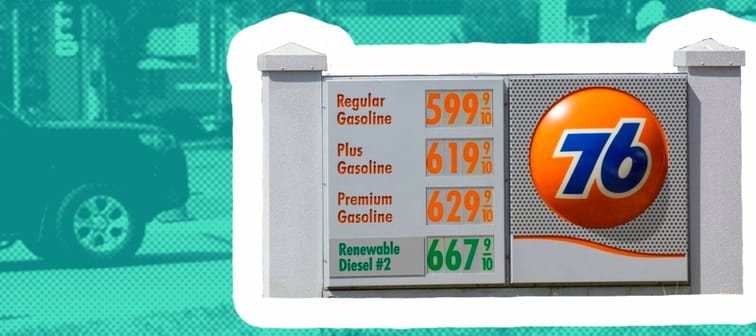What’s driving up fuel prices?
The cost of crude oil has been steadily rising ever since it tanked back at the start of the pandemic. Oil prices were already surging toward $100 a barrel when Russia invaded Ukraine and sent prices spiking above $115 amid supply concerns.
“That [invasion] sent shock waves through the oil market that have kept oil costs elevated,” AAA spokesperson Andrew Gross says.
Then in early March, the Biden administration completely banned imports of Russian crude as well as certain petroleum products, liquefied natural gas and coal. Crude oil accounts for just over half the cost of gasoline, according to the U.S. Energy Information Administration.
While the U.S. doesn’t depend heavily on Russian fossil fuels, it still imported nearly 700,000 barrels of crude oil and refined petroleum products every day last year.
A feared potential recession and the EU’s proposed Russian oil embargo — locked in a stalemate — are other major factors that could impact oil prices.
The peak summer driving season is further stressing supply and demand, as Americans head to family reunions and other getaways. Not only that, gas stations are required to bring in higher-grade gasoline to reduce emissions that cause smog. Those blends cost up to 15 cents more per gallon, according to the service station trade group NACS.
Gross, the AAA spokesperson, says more drivers are hitting the road despite the higher prices at the pump heading into Memorial Day weekend. AAA cites data from the Energy Information Administration that shows domestic gasoline stocks decreased last week, while demand for gas jumped.
The tighter supply and increased demand, along with volatile crude prices, will keep upward pressure on gas prices, AAA says.
Kiss your credit card debt goodbye
Millions of Americans are struggling to crawl out of debt in the face of record-high interest rates. A personal loan offers lower interest rates and fixed payments, making it a smart choice to consolidate high-interest credit card debt. It helps save money, simplifies payments, and accelerates debt payoff. Credible is a free online service that shows you the best lending options to pay off your credit card debt fast — and save a ton in interest.
Explore better ratesWhere gas prices are highest
If you live on the West Coast — California especially — you’re feeling the biggest pinch at the pump. Earlier this year, Los Angeles became the first major U.S. city to see an average gas price of $6 per gallon. The state’s average price is running about $6.07 this week, with at least one county’s average prices pushing close to $7 a gallon.
High gas taxes and other statewide regulations are a major factor. Glitches at a refinery in Southern California and a labor strike at another refinery north of San Francisco are of further concern.
Loren Steffy, an energy scholar at the University of Houston, says the ban on Russian oil and other energy products has an oversized impact on the West Coast and Northeast. Russia has long imported to these regions, which don’t have enough refineries to keep up with demand.
“That ban on gasoline is going to have a huge effect in California, and there’s really nothing we can do about it,” Steffy said on the CityCast podcast.
He says the Jones Act — a law that requires ships moving between U.S. ports to be built here and crewed by Americans — effectively restricts the shipping of gasoline from one area to another.
“If there was a way to suspend that restriction, for example, we could actually help to level out some of these price increases and make it less severe in certain parts of the country,” Steffy said.
When will gas prices go down?
For Memorial Day weekend, GasBuddy forecasts prices of about $4.65 per gallon, a 51% increase from last year. Over the summer through Labor Day, the gas price tracking company predicts about $4.40 per gallon nationally, though it notes that significant events could raise or lower the outcome.
The U.S. Energy Information Administration says that crude oil prices through 2022 and 2023 will depend on how much sanctions against Russia impact its oil sales, the production decisions of OPEC, and the rate at which U.S. oil and natural gas producers increase drilling.
“Although we forecast some price declines, the possibility for significant crude oil price increases and high volatility remains, given low inventory levels and the wide range of possible outcomes for oil supply, particularly from Russia,” the agency’s forecast says.
President Joe Biden has tried to push OPEC, the influential alliance of petroleum-producing nations, to pump more oil and approved releasing one million additional barrels of oil from the Strategic Petroleum Reserve each day over six months — the largest release of oil reserves in history.
Aside from releasing more oil, Biden’s plan includes a component that would — in theory — encourage U.S. companies to increase their oil production by forcing them to pay fees on idle wells and untapped land.
“If we want lower gas prices, we need to have more oil supply right now,” Biden said at a late March press conference.
When asked how much gas prices could fall from his plans, the president said they could come down 10 cents to 35 cents per gallon.
This 2 minute move could knock $500/year off your car insurance in 2024
OfficialCarInsurance.com lets you compare quotes from trusted brands, such as Progressive, Allstate and GEICO to make sure you're getting the best deal.
You can switch to a more affordable auto insurance option in 2 minutes by providing some information about yourself and your vehicle and choosing from their tailor-made results. Find offers as low as $29 a month.







